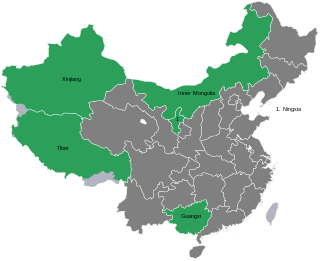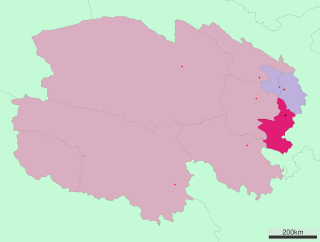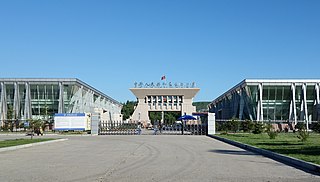Related Research Articles

Hebei is a province in North China. It is China's sixth-most populous province, with a population of over 75 million people. Shijiazhuang is the capital city. It borders Shanxi to the west, Henan to the south, Shandong and Liaoning to the east, and Inner Mongolia to the north; in addition, Hebei entirely surrounds the direct-administered municipalities of Beijing and Tianjin on land. Its population is 96% Han Chinese, 3% Manchu, 0.8% Hui, and 0.3% Mongol. Varieties of Chinese spoken include Jilu Mandarin, the Beijing dialect of Mandarin, and Jin Chinese.

Anhui is an inland province located in East China. Its provincial capital and largest city is Hefei. The province is located across the basins of the Yangtze and Huai rivers, bordering Jiangsu and Zhejiang to the east, Jiangxi to the south, Hubei and Henan to the west, and Shandong to the north. With a population of 61 million, Anhui is the 9th most populous province in China. It is the 22nd largest Chinese province based on area, and the 12th most densely-populated region of all 34 Chinese provincial regions. Anhui's population is mostly composed of Han Chinese. Languages spoken within the province include Lower Yangtze Mandarin, Wu, Hui, Gan and small portion of Central Plains Mandarin.

Lintong District, formerly Lintong County, is one of 11 urban districts of the prefecture-level city of Xi'an, the capital of Shaanxi Province, Northwest China. The district was approved to establish from the former Lintong County (临潼县) by the Chinese State Council on June 25, 1997. The Terracotta Army and the Mausoleum of the First Qin Emperor was discovered in March 1974 near this district. The district borders the prefecture-level cities of Xianyang to the northwest and Weinan to the east, Gaoling County to the northeast, Baqiao District to the southeast, Lianhu and Xincheng Districts to the south, and Chang'an District to the southwest.

The autonomous regions are one of four types of province-level divisions of the People's Republic of China. Like Chinese provinces, an autonomous region has its own local government, but under the law of the People's Republic of China, an autonomous region has more legislative rights, such as the right to "formulate self-government regulations and other separate regulations." An autonomous region is the highest level of minority autonomous entity in China, which has a comparably higher population of a particular minority ethnic group.

Ankang is a prefecture-level city in the south of Shaanxi Province in the People's Republic of China, bordering Hubei province to the east, Chongqing municipality to the south, and Sichuan province to the southwest. It covers an area of 23,391 square kilometres (9,031 sq mi) and consists Xunyang, a county-level city, one urban district, and eight counties. Its total population was 2,493,436 people according to the 2020 Chinese census, with 1,244,784 living in urban areas.

Deyang is a prefecture-level city of Sichuan province, China. Deyang is a largely industrial city, with companies such as China National Erzhong Group and Dongfang Electric having major operations there. The city is rich in history, with the Sanxingdui archeological site in Guanghan uncovering a rich trove of bronze and gold masks. More recently, Deyang was greatly afflicted by the 2008 Sichuan earthquake, which particularly impacted its county-level cities of Mianzhu and Shifang, in Deyang's northwest. Deyang spans an area of 5,911 km2 (2,282 sq mi).
Fuquan is a county-level city in east-central Guizhou province, China.

Changping District, formerly Changping County (昌平县), is a district situated in the suburbs of north and northwest Beijing. Changping has a population of 2,269,487 as of November 2020, making it the most populous suburban district of Beijing.

Huangnan Tibetan Autonomous Prefecture is an autonomous prefecture of Eastern Qinghai, China, bordering Gansu to the east. The prefecture has an area of 17,921 km2 (6,919 sq mi) and its seat is in Tongren County.

Litang County is southwest of Garzê Tibetan Autonomous Prefecture, in Sichuan, China, in the traditional Tibetan region of Kham. It contains 7 towns and a population of more than 60,000 in 2020. Due to its elevation and mountainous terrain, the county has an alpine climate. Several famous Tibetan Buddhist figures were born here, including the 7th Dalai Lama, the 10th Dalai Lama, the 11th Tai Situpa, four of the Pabalas, as well as the 5th Jamyang Zhépa of Labrang Monastery. Düsum Khyenpa, 1st Karmapa Lama, returned here and built Kampo Nénang Monastery and Pangphuk Monastery. It also has strong connections with the eponymous hero of the Epic of King Gesar.

Baqiao District is one of 11 districts of the prefecture-level city of Xi'an, the capital of Shaanxi Province, Northwest China. The district borders Gaoling District to the north, Lintong District to the northeast, Chang'an District to the southeast, Yanta and Xincheng Districts to the west, and Weiyang District to the northwest. The district spans an area of 332 square kilometres (128 sq mi), and has a population of 595,124 as of 2010.

Gaoling District is one of 11 urban districts of the prefecture-level city of Xi'an, the capital of Shaanxi Province, Northwest China. The most densely populated of the ten districts of Xi'an, the district borders the prefecture-level city of Xianyang to the northwest, Lintong District to the east, Baqiao District to the south, and Weiyang District to the southwest.

Junlian County is a county of Sichuan Province, China. It is under the administration of Yibin city. At the end of 2019 it has a population of 450,176 of which 151,322 in the urban area. It is one of the most important coal mining areas of Sichuan.

Jiuzhaigou County is a county of Sichuan Province, China. It is under the administration of the Ngawa Tibetan and Qiang Autonomous Prefecture. Formerly called Nanping County, it was renamed in 1998 to reflect the fact that the Jiuzhaigou Valley is located within its administration. The county seat, Nanping, was created in 2013 by the merger of Yongle Town (永乐镇), Yongfeng Township (永丰乡), and Anle Township (安乐乡).

Heishui County is a county in the north of Sichuan Province, China. It is under the administration of the Ngawa Tibetan and Qiang Autonomous Prefecture. The county has an area of 1,682 square miles (4,356 km2) and its average elevation is 11,627 feet (3,544 m). As of 2016, the county has a population of 61,744.

Changbai Korean Autonomous County, or simply Changbai County, is a county in southern Jilin province, China, facing Hyesan, North Korea. It is under the administration of the city of Baishan, 160 kilometres (99 mi) to the west-northwest, and has an area of 2,497.6 km2 (964.3 sq mi). The county has a total population of 85,000 people, 14,000 of which are ethnic Koreans.

Guanshanhu District, formerly the Jinyang New Area, is one of 6 urban districts of the prefecture-level city of Guiyang, the capital of Guizhou Province, in Southwest China. Located to the northwest of Guiyang's city centre, Guanshanhu District is situated beyond the city's mountains on high-plains interspersed with rolling hills, at an average altitude of 1,200 metres (3,900 ft). The district spans an area of 309.48 square kilometres (119.49 sq mi), and has a population of 642,634 as of 2020.
References
- ↑ "2010 Population Census of China - United Nations Statistics".
- ↑ Chow, Professor Esther Ngan; Chow, Esther Ngan-Ling; Berheide, Catherine White (January 1994). Women, the Family, and Policy: A Global Perspective. ISBN 9780791417850.
- ↑ Peters, Susan Jeanne (26 November 2013). Education and Disability in Cross-Cultural Perspective. ISBN 9781135811587.
- ↑ Chen, Jianfu (14 July 1999). Chinese Law: Towards an Understanding of Chinese Law. ISBN 9041111867.